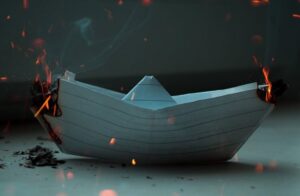 Introduction
Introduction
A bills of lading is a contractual document issued by the carrier by sea of goods which such carrier takes possession of and transports. Generally, a bill of lading would contain details about the transported goods such as the type, quantity, weight, value, and date of shipment of such goods. From a definitional perspective, it is difficult to give a precise definition of a bill of lading, but it could certainly be said to possess the following essential attributes:
(i)It serves as a transport receipt which the carrier gives to the seller for transporting his goods;
(ii)It serves as evidence of contract between the carrier and the exporter; and
(iii)It serves as a document of title for the importer or the buyer.
From the above, it is evident that there are the following parties primarily involved: Continue reading “Bills of Lading: Basic concepts and issues”



 Marine surveyors and boat owners are regularly heard to say there is a minimum 4.0mm of hull thickness required at time of survey of a steel narrowboat. Some brokers even publish videos of such information, with some surveyors enforcing it (Whilton Marina, 2012 and 2016). Boaters are subject to it and repair often follows. In a recent article, Geoff Waddington (2021) explains there is confusion in the industry about wastage limits, and consequently acceptable residual hull plate thicknesses, and opinions among surveyors ‘vary wildly’, with some quoting 3mm acceptable minimum plate thickness, others using percentage loss. This short paper explores what a standardised acceptable limit for diminution, and therefore residual steel plate thickness for narrowboats, could be. It describes a variety of methods of calculating the design plate thicknesses (scantlings) and the minimum acceptable residual plate thickness. In doing so, this paper aims to serve as a guide for inland waterways marine surveyors, boat owners, repairers, and insurers alike.
Marine surveyors and boat owners are regularly heard to say there is a minimum 4.0mm of hull thickness required at time of survey of a steel narrowboat. Some brokers even publish videos of such information, with some surveyors enforcing it (Whilton Marina, 2012 and 2016). Boaters are subject to it and repair often follows. In a recent article, Geoff Waddington (2021) explains there is confusion in the industry about wastage limits, and consequently acceptable residual hull plate thicknesses, and opinions among surveyors ‘vary wildly’, with some quoting 3mm acceptable minimum plate thickness, others using percentage loss. This short paper explores what a standardised acceptable limit for diminution, and therefore residual steel plate thickness for narrowboats, could be. It describes a variety of methods of calculating the design plate thicknesses (scantlings) and the minimum acceptable residual plate thickness. In doing so, this paper aims to serve as a guide for inland waterways marine surveyors, boat owners, repairers, and insurers alike. 
 The most important of all international maritime safety conventions is the International Convention for the Safety of Life at Sea (
The most important of all international maritime safety conventions is the International Convention for the Safety of Life at Sea (

 Many agricultural bulk cargos and forestry products are required to undergo fumigation on board ships to prevent infestation. However, to achieve the efficacy, the fumigation operation started at the load port often needs to continue in transit to the discharge port. Such “in-transit fumigation” may endanger the safety and lives of crew members and shore based personnel if not handled properly. The toxicity of the fumigant makes it extremely important to raise awareness of the dangers of in transit fumigation.
Many agricultural bulk cargos and forestry products are required to undergo fumigation on board ships to prevent infestation. However, to achieve the efficacy, the fumigation operation started at the load port often needs to continue in transit to the discharge port. Such “in-transit fumigation” may endanger the safety and lives of crew members and shore based personnel if not handled properly. The toxicity of the fumigant makes it extremely important to raise awareness of the dangers of in transit fumigation.
 The marine industry has long relied on the expertise and knowledge of cargo surveyors to ensure the safe and efficient transport of goods across the world’s oceans. In today’s rapidly evolving information age, knowledge and expertise is not just power—it is a strategic asset that drives innovation, growth, and competitive advantage. As marine survey businesses navigate an increasingly complex landscape, the integration of artificial intelligence (AI) has the potential to revolutionise the way knowledge is harnessed, analysed and applied across all industries, and the marine survey industry is no different.
The marine industry has long relied on the expertise and knowledge of cargo surveyors to ensure the safe and efficient transport of goods across the world’s oceans. In today’s rapidly evolving information age, knowledge and expertise is not just power—it is a strategic asset that drives innovation, growth, and competitive advantage. As marine survey businesses navigate an increasingly complex landscape, the integration of artificial intelligence (AI) has the potential to revolutionise the way knowledge is harnessed, analysed and applied across all industries, and the marine survey industry is no different.